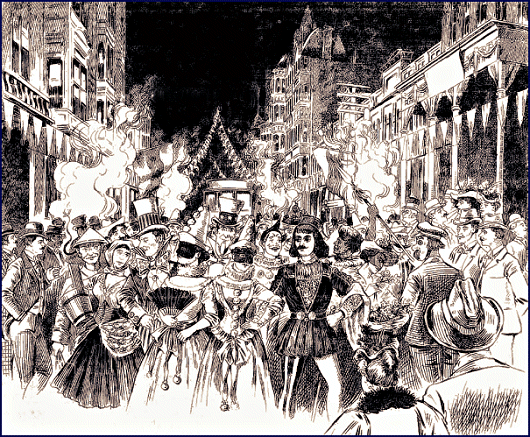
Los Angeles Times, April 25, 1897
Spring Street revelers on All Fools Night
Thursday, March 29, 2007
Page 15
REMINISCING (Column)
‘La Fiesta’ Continues—but Suddenly Is Cancelled
By ROGER M. GRACE
By the time the third week-long “La Fiesta de Los Angeles” had been held in 1896, the expectation was that the event would be staged the following year, and each year for decades to come.
“The discussion as to the advisability of continuing the annual spectacle famous as La Fiesta de Los Angeles called out much enthusiasm at the meeting of the Merchants’ Association last night,” a Los Angeles Times story of May 28, 1896 begins. “Mr. [Herman W.] Frank started the ball rolling by calling for an expression.
“Mr. [Hans] Jevne favored its continuance and said he believed $10 was brought from without to every dollar spent by the residents. The three fiestas have been eminently successful.”
That was the consensus—and a motion was carried to form a permanent organization to oversee the annual event.
The next rendition of it took place April 20-24, 1897. There were costumes and masks, pennants and bunting, horses and floats, bands and singers. An estimated 5,500 school children, each carrying a small American flag, marched, 25 abreast, reviewed by the queen of the pageant. Spectators saw native Americans performing tribal dances, a cavalcade of caballeros, and a procession of Chinese carrying a 500-foot paper dragon.
The merchants were solidly behind the event, supervised by a “Committee of 30.”
“Fiesta colors are uniquely displayed in Jevne’s show window on Spring street,” a March 26, 1897, item in the Times read. “The Diamond match company has manufactured a special brand of red, yellow and green matches for the fiesta, and upon each box appears an exact reproduction of the fiesta seal. Jevne has made a very attractive window display of the first consignment.”
Red, yellow and green were the event’s official colors—representing wine, oranges, and olives.
At its annual meeting on May 17, 1897, the Merchants’ and Manufacturers’ Assn., a combined organization headquartered in the Wilcox Building, passed a resolution declaring “that it is the sense of this association that the fiesta celebration be made a permanent institution....”
That isn’t to say that there weren’t detractors. At that very meeting, an attorney, Edwin Baxter, who was not a member of the organization, received permission to speak. He bemoaned the tendency of the fiesta to distract children from their studies and, as the Times article of May 18 recounts it, “he characterized All-Fools night as a grand and glorious debauch.”
In the 1897 program, that event had borne this description: “Revelry of Maskers in the public streets, participated in by rich and poor, old and young.” But others saw it as Baxter did: all-night carousing marked by abandonment of morals.
 |
|
|
Los Angeles Times, April 25, 1897 |
|
|
Spring Street revelers on All Fools Night |
Around that time, newspapers were spotlighting that aspect of the merrymaking. An editorial in the Herald decries the presence of respectable women on the city’s streets in a drunken state...and one in the Redlands Facts asserts that “orgies” during the fiesta “were one of its main features.”
A March, 1898, article in the Los Angeles Record proclaims that 98 illegitimate births were linked to escapades during All Fools’ Night in 1896.
In response, the Committee of 30 determined on March 17, 1898 that “All Fools’ Night shall not be considered a part of La Fiesta, and shall not have a place on the programme.” That having been done, there seemed no impediment to holding the fiesta, as scheduled, in May.
But the political situation supplied the impediment. A few days before the onset of the Spanish American War on April 24, 1898, the Committee of 30 decided to call off the event on the ground that it would be “unpatriotic” to be conducting festivities at a time of fighting. But the root obstacle appeared to be that anti-Spanish sentiment was so high that a “fiesta” recalling the city’s Spanish heritage was not destined to meet with success.
There would be future fiestas, staged sporadically, but momentum and spirit rivalling that of the 1890s would emerge only once again, when Los Angeles in 1931 celebrated its 150th anniversary with a 10-day bash.
Copyright 2007, Metropolitan News Company